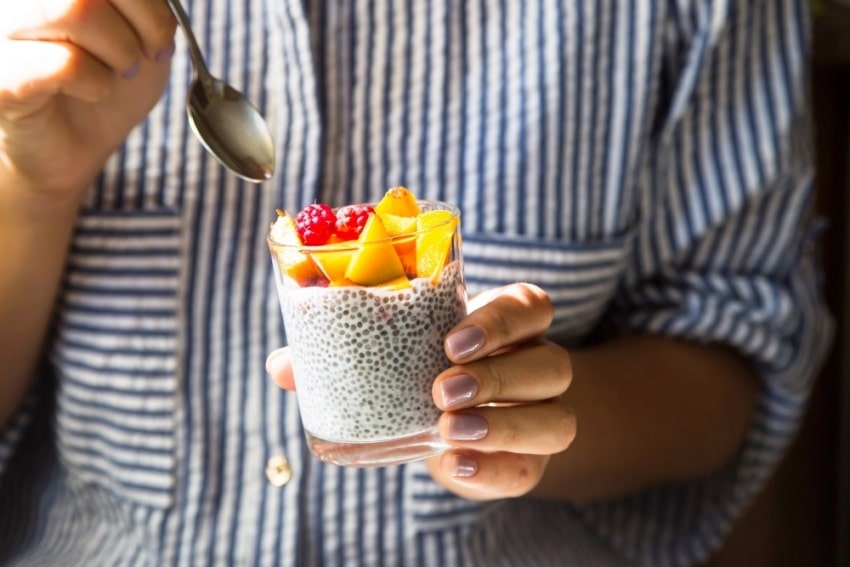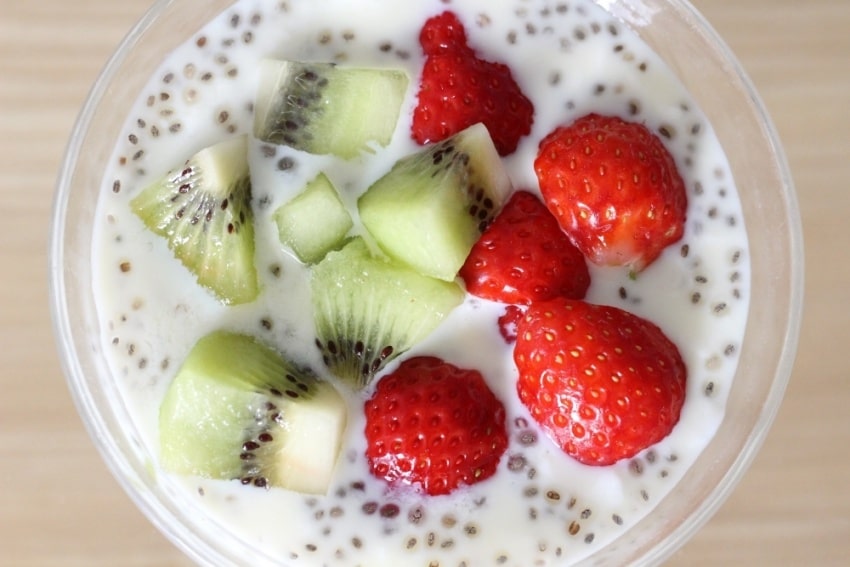One thing I can always get my kids to eat is a yummy bowl of dessert. Something sweet even seems to be an all-around favorite in my house. Except, there’s one catch – it’s actually healthy for you!
And while there are many ways to whip up a low-sugar, all organic dessert for your little one, let’s discuss one of the easiest ingredients to achieve such a delicacy.
Chia seeds, the boost of healthy omegas, the fiber you didn’t know they needed, the kid-friendly superfood!
And while it runs for a high price in the prepackaged foods at the store, you can make it right at home for a 10th of the cost, exactly the way your family likes it.
In this article
- What Are Chia Seeds and Where Do They Come From
- At What Age Can Babies Safely Consume Chia Seeds
- Save Costs On Baby Foods By Implementing Chia Seeds Into Your Baby’s Diet
- How to Prepare Chia Seeds For Babies Under One-Years-Old
- Can Babies Choke On Chia Seeds Or Is This A Myth
- What Is The Nutritional Value of Chia Seeds and Why Are They Beneficial for Kids
- What Are Omega-fatty Acids
- Are Chia Seeds Safe For Allergen Sensitive Kids Too
- Kid-friendly Chia Seed Recipes for Children
- Why are Chia Seeds Considered One of the Top Superfoods for Kids in the First Place
- In Conclusion
What Are Chia Seeds and Where Do They Come From
I bet you’re going to be as surprised as I was to hear that chia seeds belong in the same plant family as the mint plant.
It originally grew in Guatemala Mexico but when surrounding countries found out just how desirable this little edible seed was to the world – they began growing it too!
It’s grown in mass amounts in the countries of Peru, Australia, Bolivia, and Argentina. It’s packed with vitamins, giving all those who consume this tiny superfood an extra boost of nourishment.
The beautiful plant flowers little flowers yearly that are blue, white, or purple. The plant is native to desert regions making it an eco-friendly food source too! They pack a big punch for not needing much water to do it.
For ages, the Aztecs and indigenous people have used chia seeds as medicine in their cultures.
View in gallery
At What Age Can Babies Safely Consume Chia Seeds
There’s nothing better to give your rapidly growing baby than the blessing of nutritionally dense foods. Your baby can eat chia seeds by 6 months at the earliest, which is when most parents start their babies off with solid foods anyway.
In other words, your baby can eat chia seeds right from the get-go, and that’s just what they should do for the best start in life.
These little seedlings will support your baby’s growth in all the best ways, and the best part is how easy they are for them to actually consume.
Save Costs On Baby Foods By Implementing Chia Seeds Into Your Baby’s Diet
Chia seeds are such a cost-friendly option for parents, literally, an entire bag from Costco will last months. Why is this, you ask?
That’s because when they’re soaked in water they expand triple their original size. Think 3 bags in one once they’re fully prepared. They won’t go bad and only take a few minutes to be ready to consume
Busy parents need all the time they can get, we understand! This is where chia seeds become your best friend or best food friend – they only take a bit of time to be ready.
- NUTRIENT-DENSE SUPERFOOD - rich in omega-3 fatty acids, fiber, protein, iron and antioxidants
- NEUTRAL TASTE - chia seeds are virtually tasteless and can be added to your favorite foods. For added texture and protein, we recommend sprinkling chia seeds over oatmeal or adding them to smoothies, salads or yogurt for a satisfying and filling snack.
- HYDROPHILIC PROPERTIES - these mighty seeds hold up to 12x their weight offering powerful thickening abilities. Make a vegan egg substitute using 1 tablespoon of chia seeds to 3 tablespoons of water.
Prices pulled from the Amazon Product Advertising API on:
Product prices and availability are accurate as of the date/time indicated and are subject to change. Any price and availability information displayed on [relevant Amazon Site(s), as applicable] at the time of purchase will apply to the purchase of this product.
How to Prepare Chia Seeds For Babies Under One-Years-Old
Chia seeds are simple to prepare for babies under 1 year of age. Below is a list of methods you can use to prepare them for your young child.
Six months to One-Year-Old
The best thing to start your 6-month-old with is a breastmilk or formula based pudding. Though, you can also use plant-based milk like almond, soy, or hemp. This will be the most gentle on their gut and digestive tract.
Use 1 cup of milk to ¼ cup of chia seeds for the best texture that your baby can swallow easily. Add a bit of sweetener like stevia if you’d like to that’s sugar-free.
After you mix the milk in with the seeds, allow it to soak for 30 minutes before serving it to your baby.
Have a place ready for your little one to be a messy eater. A baby spoon will be helpful to encourage self-serving the pudding. Prepare to have a lot to clean up, and don’t forget to have fun!
View in gallery
Twelve to Eighteen months
This is the age of eating more than drinking. This is how your baby will get the most calories out of their meals.
You can offer smoothies if your baby has had some solid foods already, but pudding is still a great option for introducing chia seeds into the diet.
You can also make chia seed pancakes or sweetbreads that your growing little one will surely love! Think, PB chia seed pancakes and fruit on top for a great finger food meal that your baby won’t have trouble getting down.
Eighteen to Twenty-Four months
Chocolate chia seed pudding, pre-soaked chia gel with other meals, or chia seed smoothies at anytime now that your child can eat regular foods as most adults can. Your baby will enjoy sweet chia seed meals most likely.
Try our defrosted fruits with a bit of peanut butter, and chia seed gel mixed in with it for a healthy snack that sustains them for a bit longer.
Your child will want to eat snacks along with their meals so it’s great to serve snacks and meals that sustain your baby longer than an hour. That makes it easy for you as a parent and keeps your kid happy in the long run.
Chia seeds don’t go bad! They can last as many as five years on the shelf when stored in a cool dry place.
On a Side Note for preparation
Be sure to grind or soak chia seeds 30 minutes prior to offering them to your baby.
The bag that contains the chia seeds will give specific directions on how much liquid to seed ratio to avoid them being too thick for adults. You can add extra liquid for your child if you’re concerned.
Can Babies Choke On Chia Seeds Or Is This A Myth
The only time that chia seeds become a choking hazard to babies is when the seeds aren’t prepared properly. If they’re given to a baby dry, then babies aren’t able to properly swallow.
Look out for those lumps and bumps that form in chia seed ‘pudding’ you’ll need to break those up before serving to your child under a year old.
It would be difficult for a baby to choke on chia seeds and not many of us parents have seen it happen. They are one of the friendliest baby foods out there.
That said, if your baby has been diagnosed with dysphagia or has difficulty swallowing then it’s best to speak with your child’s pediatrician before serving them to your baby.
View in gallery
What Is The Nutritional Value of Chia Seeds and Why Are They Beneficial for Kids
Chia seeds are no doubt one of the greatest superfoods that are actually kid-friendly! They’re small, but if you’ve ever had them personally, you’ll realize that they fill you up with just a few spoonfuls.
Before I gave them to my kids more frequently, I’d question if they were even worth it. Yet, what stood out to me the most was the sustained boost of energy they had for hours after consuming them. They were actually filling them up.
And since they digest slowly in the digestive tract because of the high fiber content, they actually help their bodies absorb natural sugars in the other foods they eat outside of chia seeds.
Kids need a lot of protein
Your kid needs loads of protein, or at least a good amount of plant-sourced protein to sustain their healthy hair, nails, and tissue growth. Chia seeds offer a whopping 16.5grams of protein for 3.5 grams of prepared seeds.
Fiber for optimal digestive health
Fiber takes the cake for chia seeds nutritional boosts. There’s a whopping 34.4 grams of fiber in a single serving. Fiber softens and increases the size of your stool, making it easier for your kid to use the bathroom.
Fiber acts as an intestinal cleanser as well, so as it moves through the intestine it scrubs the walls too.
Calcium helps with strong bones and teeth
One thing we all have heard on a regular basis is that kids need calcium and a lot of it. For strong bones, teeth, and to avoid the disease of Rickets.
That’s the entire notion behind giving your kid milk on a regular basis, right? Well, it’s even better to give your kid a plant-based source of calcium instead of a source from cow-milk.
Plant-based sources of protein are easy to digest in our bodies compared to animal-based calcium sources like cows milk. Calcium is the most abundant mineral in the body.
Manganese assists in overall growth
Some kids have an allergy to other nuts and seeds. In this case, chia seeds are a great option since they have such a low allergy rate.
Manganese is essential for kids to have proper growth and development, especially in the years they’re making massive leaps in these areas.
View in gallery
Phosphorus is a result of high-protein foods
Chia seeds are packed with phosphorus since they are also packed with protein. Known to contribute to proper bone health and development, phosphorus is crucial for the young bodies of children.
Copper supports heart health
Most people in the United States are low in the mineral copper. This goes for young kids too. Chia seeds are a good option for adults and kids to get more of this vitamin on a regular basis. Copper also contributes to a healthy functioning heart.
Magnesium, the cure-all
Magnesium, better known as the cure-all. When I was pregnant, my midwife would tell me to take magnesium for practically everything from constipation to cramps in my calves. Kids need magnesium for most of the same reasons.
Their bodies are growing so quickly, sometimes they’ll get growing pains or other ailments in their muscles. And what about anxiety in children? Magnesium calms this too, bringing an overall sense of well-being for even the youngest kids.
What Are Omega-fatty Acids
You’ve probably heard about omegas at some point in your life. They’re raved about by health-fanatics. Assisting with brain function is the primary role they play in the body. Most people gain their omegas from fish sources.
Cod liver is a widely used source by consumers, but plant-based families are left wondering how they can get their omegas in, too.
- HEART, BRAIN, AND JOINT HEALTH - A single teaspoonful of Carlson Cod Liver Oil provides 1,100 mg of omega-3s, including EPA and DHA, which support heart, brain, vision, and joint health. To ensure maximum freshness, Cod Liver Oil is closely managed from sea to store.
- AWARD-WINNING TASTE AND QUALITY - Carlson Cod Liver Oil has received numerous awards for its taste and quality. Carlson Cod Liver Oil is available in lemon, fruit splash, or natural flavor.
Prices pulled from the Amazon Product Advertising API on:
Product prices and availability are accurate as of the date/time indicated and are subject to change. Any price and availability information displayed on [relevant Amazon Site(s), as applicable] at the time of purchase will apply to the purchase of this product.
Until recently if you were plant-based, you basically just opted out of focusing on omega’s until chia seeds came around that is.
Chia seeds are an amazing source of fatty acids, containing omega-3 alpha-linoleic acid or ALA making up 75% of fat and the other roughly 20% of acids being omega 6 fatty acids.
How Do Omega 3 Fatty Acids Benefit Children In General
Omega 3 fatty acids help kids maintain a healthy well-functioning heart. Kids are working their hearts all the time between playing and growing.
Their heart will beat between 98-120 beats per minute at the age of 2 years old, and gradually lower to between 75-118 beats per minute by the age of 7 years old.
All of this growth takes a healthy heart working properly. Alongside the heart, omegas help develop the nervous system of children. In fact, kids need an increased amount of omegas to develop their nervous system optimally.
The nervous system is what allows your child to be relaxed on a regular basis. When children have a stressed-out nervous system, they become stressed or anxiety-driven more easily. The cardiovascular system of children also benefits from chia seeds.
When kids run and play harder, they will naturally breathe more heavily. Requiring more oxygen and blood to be carried away from and to the heart, the cardiovascular system at its best does this efficiently.
The little oval-shaped gelatin seeds provide nourishment to the cardiovascular system through the abundance of omega’s found in their nutritional makeup.
Are Chia Seeds Safe For Allergen Sensitive Kids Too
If your kid is known to have a sesame seed allergy, then they might be more at risk of being allergic to chia seeds.
Although, a chia seed allergy is practically unheard of in society. The link between being allergic to sesame seeds and chia seeds has been linked by limited studies.
You can always talk to your child’s pediatrician beforehand if you’re worried that your kid might be allergic to chia seeds.
Before introducing any new foods to your child, start with a few tablespoons, and gradually move to bigger portions if there have been adverse reactions.
View in gallery
Kid-friendly Chia Seed Recipes for Children
Feeding your kids chia seeds doesn’t have to be difficult. I must admit though when I first became interested in chia seeds for my family. I really wasn’t sure what to do with them.
I stood there in the kitchen, scratching my head contemplating the best way to prepare them for the kids. I had always used them in smoothies myself, but that wasn’t exactly ideal for my little ones since they didn’t like how cold smoothies are.
With a whole lot of creativity and some online advice from other superfood loving moms, I found some of the best kid-friendly chia seed recipes.
Don’t get discouraged if your kids don’t like what you give them the first time around. It takes 10 times of trying a new food before taste buds can officially decide they don’t like a certain food.
Chia seed overnight no-cook oatmeal
What easier meal can there be than the one you don’t even have to cook. If there’s one thing that chia seed recipes grant parents it’s the ability to choose the one you don’t even have to cook!
This oatmeal can be prepared in weekly batches too, this is especially great if you’re a mother of young kids.
To make it combine:
- 2 cup of rolled oats
- 1.5 tablespoon of chia seeds
- 23/4 cup of almond milk (or a milk of your choice)
- Add any dried fruits, shredded coconut, or seeds
Store it in a covered glass container overnight in the fridge. Store it for 4 days in the fridge. Serve cold, and add any toppings you desired.
Chocolate chia seed pudding
Once again, a recipe that you won’t have to cook. Overnight chocolate chia seed pudding, it’s sweet, it’s chocolaty, and we know parents won’t be able to hold back from having a bit themselves.
To make combine the following ingredients in a big bowl:
- ¼ cup of cacao powder (unsweetened)
- 3-5 tablespoons of maple syrup
- 1/2 teaspoon of cinnamon
- 1 pinch of Himalayan salt
- ½ teaspoon of vanilla extract
- 1 ½ cups of almond milk or canned coconut milk for an extra creamy texture
- ½ cup chia seeds.
Store in a covered bowl in the fridge for up to 4 days or best served fresh.
View in gallery
Additional recipe ideas that are popular among kids and toddlers
There are plenty of other ways to include chia seeds into your children’s foods, though these ways are the most popular among kids and toddlers.
Try making homemade dairy-free yogurt, sprinkle them over veggies, chia seed superfood muffins, homemade crockpot soups, thicken the sauce, or gravy by adding in a few chia seeds.
Why are Chia Seeds Considered One of the Top Superfoods for Kids in the First Place
Chia seeds are no doubt one of the greatest superfoods for kids. According to parents.com, they made the top 10 list of kid-friendly superfoods specifically because of their protein, fiber, magnesium, and fat content.
They’re packed to help with children’s brain function, nervous system development, and the continuous building of small and large muscle groups.
The more chia seeds you can implement in your child’s diet, the better off they will be. During those young years, kids are growing at an incredible rate. Think quality foods over quantity!
In Conclusion
Parents find chia seeds to be extremely manageable to incorporate in their family’s meals once they get the hang of where to include them.
My kids love the days I tell them we’re having pudding, and their energy levels soar high on those days. Take chia seeds camping, on hikes, or pack them in school lunches too.
Chia seeds can be purchased at any local grocery store in the natural aisle, or order some online too. They practically don’t go bad as long they are stored correctly in a cool dry place.
Any soaked chia seeds can be stored in the fridge for 4-5 days and remain good tasting. These fun little seeds are a game-changer for parents who want convenience and health all-in-one.






